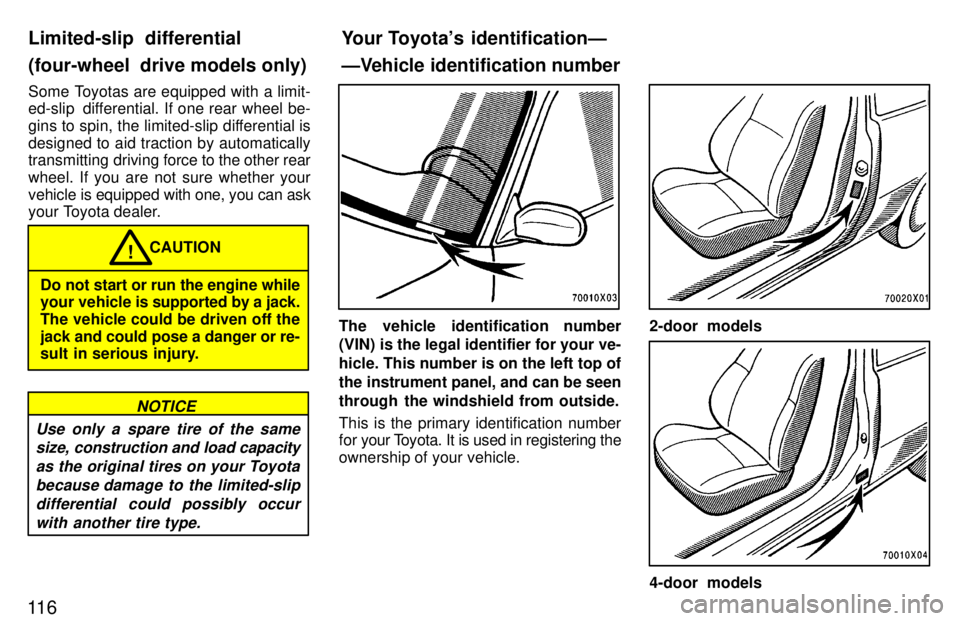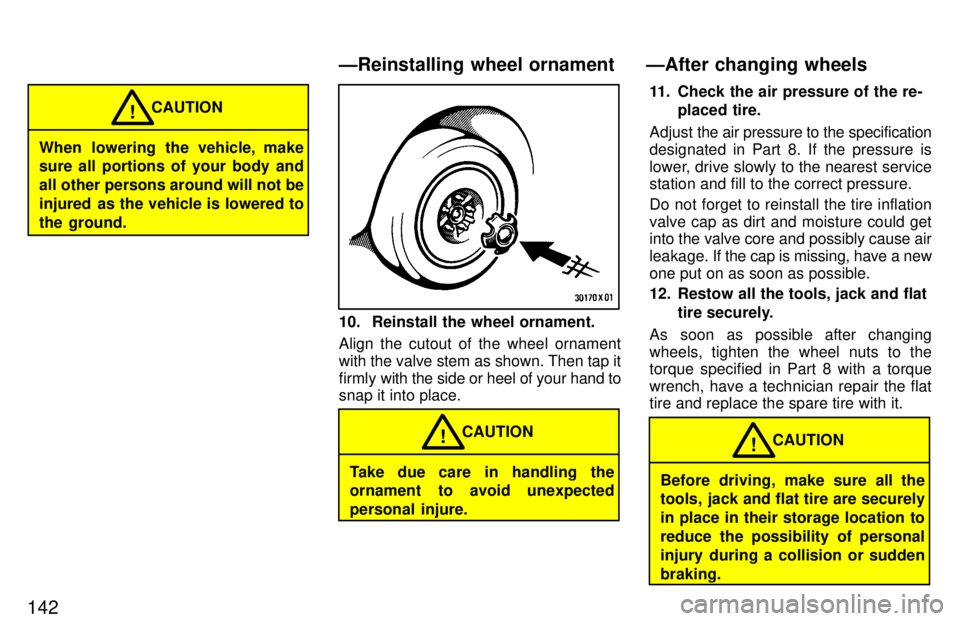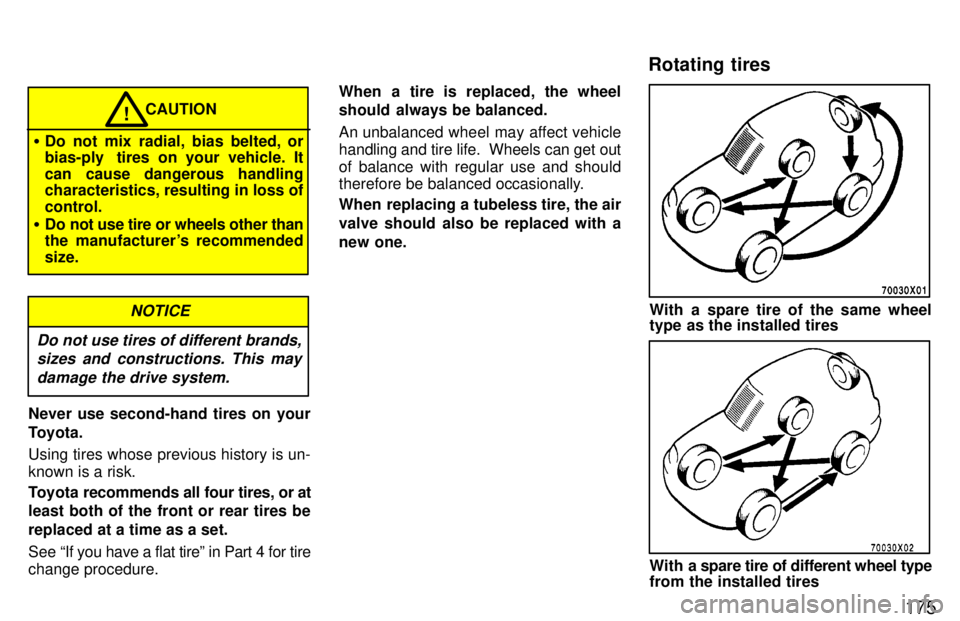Page 117 of 198

11 6Some Toyotas are equipped with a limit-
ed-slip differential. If one rear wheel be-
gins to spin, the limited-slip differential is
designed to aid traction by automatically
transmitting driving force to the other rear
wheel. If you are not sure whether your
vehicle is equipped
with one, you can ask
your Toyota dealer.
CAUTION!
Do not start or run the engine while
your vehicle is supported by a jack.
The vehicle could be driven off the jack and could pose a danger or re-
sult in serious injury.
Use only a spare tire of the same
size, construction and load capacity
as the original tires on your Toyota because damage to the limited-slip differential could possibly occurwith another tire type.
NOTICE
The vehicle identification number
(VIN) is the legal identifier for your ve- hicle. This number is on the left top of
the instrument panel, and can be seen
through the windshield from outside.
This is the primary identification number
for your T oyota. It is used in registering the
ownership of your vehicle.2-door models
4-door models
Limited-slip differential
(four-wheel drive models only)
Your Toyota's identificationÐ
ÐVehicle identification number
Page 138 of 198
138
To remove the spare tire:
Turn the hold-down nuts counterclock-
wise with the wheel nut wrench and re-move them.
When storing the spare tire, put it in place
and secure it to prevent it from flying for-
ward during a collision or sudden braking.2. Block the wheel diagonally oppo-
site the flat tire to keep the vehicle from rolling when it is jacked up.
When blocking the wheel, place a wheel
block from the front for the front wheels or
from the rear for the rear wheels.Steel wheels
Aluminum wheels
ÐBlocking the wheel ÐRemoving wheel ornament
Page 140 of 198
140
6. After making sure that no one is inthe vehicle, raise it high enough so
that the spare tire can be installed.
Remember you will need more ground
clearance when putting in the spare tirethan when removing the flat tire.
To raise the vehicle, insert the jack handle
into the jack (it is a loose fit) and turn it
clockwise. As the j ack touches the vehicle
and begins to lift, double-check that it is
properly positioned.
Never get under the vehicle when
the vehicle is supported by the jack alone. CAUTION
!
7. Remove the wheel nuts and change
tires.
Lift the flat tire straight off and put it aside.
Roll the spare wheel into position and
align the holes in the wheel with the bolts.
Then lift up the wheel and get at least thetop bolt started through its hole. Wigglethe tire and press it back over the other bolts. ÐChanging wheels
ÐRaising your vehicle
Page 142 of 198

142
When lowering the vehicle, make sure all portions of your body and
all other persons around will not be
injured as the vehicle is lowered tothe ground.CAUTION
!
10. Reinstall the wheel ornament.
Align the cutout of the wheel ornament with the valve stem as shown. Then tap it
firmly
with the side or heel of your hand to
snap it into place.
Take due care in handling the
ornament to avoid unexpected
personal injure. CAUTION
! 11. Check the air pressure of the re-
placed tire.
Adjust the air pressure to the specification
designated in Part 8. If the pressure is
lower, drive slowly to the nearest service station and fill to the correct pressure.
Do not forget to reinstall the tire inflation valve cap as dirt and moisture could get into the valve core and possibly cause air
leakage. If the cap is missing, have a new
one put on as soon as possible.
12. Restow all the tools, jack and flat
tire securely.
As soon as possible after changing
wheels, tighten the wheel nuts to the torque specified in Part 8 with a torque wrench, have a technician repair the flat tire and replace the spare tire with it.
Before driving, make sure all the
tools, jack and flat tire are securely in place in their storage location to
reduce the possibility of personal
injury during a collision or suddenbraking. CAUTION
!
ÐReinstalling wheel ornament ÐAfter changing wheels
Page 169 of 198

173
2-door models
4-door modelsKeep your tire pressures at the proper level.
The recommended cold tire pressures,
tire size and the vehicle capacity weight
are also given in Part 8. They are also on the tire pressure label shown.
You should check the tire pressures every two weeks, or at least once a month. And
do not forget the spare!
Incorrect tire pressure can reduce tire
life and make your vehicle less safe todrive.
Low tire pressure results in excessive
wear, poor handling, reduced fuel econo-
my, and the possibility of blowouts from
overheated tires. Also, low tire pressure
can cause poor sealing of the tread bead.
If the tire pressure is excessively low,
there is the possibility of wheel deforma- tion and/or tire separation.
High tire pressure produces a harsh ride,
handling problems, excessive wear at thecenter of the tire tread, and a greater
pos-
sibility of tire damage from road hazards.
If a tire frequently needs refilling, have it
checked by your Toyota dealer.
The following instructions for check-
ing tire pressure should be observed: �
The pressure should be checked
only when the tires are cold. If your
vehicle has been parked for at least 3 hours and has not been driven formore than 1.5 km or 1 mile since, you
will get an accurate cold tire pressurereading.
� Always use a tire pressure gauge.
The appearance of a tire can be mis-
leading. Besides, tire pressure that
are even just a few pounds off can de-
grade handling and ride.
� Take special care when adding air
to the compact spare tire. The
smaller tire size can gain pressure
very quickly. Add compressed air insmall quantities and check the pres- sure often until it reaches the specified
pressure.
� Do not bleed or reduce tire pres- sure after driving. It is normal for the
tire pressure to be higher after driving.
� Never exceed the vehicle capacity weight. The passenger and luggage
weight should be located so that the
vehicle is balanced.
Checking tire pressure
Page 171 of 198

175
CAUTION!
� Do not mix radial, bias belted, or
bias-ply tires on your vehicle. It
can cause dangerous handling
characteristics, resulting in loss of control.
� Do not use tire or wheels other than
the manufacturer's recommended size.
Do not use tires of different brands,
sizes and constructions. This may
damage the drive system.
NOTICE
Never use second-hand tires on your
Toyota. Using tires whose previous history is un- known is a risk.
Toyota recommends all four tires, or at
least both of the front or rear tires be
replaced at a time as a set.
See If you have a flat tireº in Part 4 for tire
change procedure. When a tire is replaced, the wheel
should always be balanced.
An unbalanced wheel may affect vehicle
handling and tire life. Wheels can get out
of balance with regular use and should
therefore be balanced occasionally.
When replacing a tubeless tire, the air
valve should also be replaced with a
new one.
With a spare tire of the same wheel
type as the installed tires
With a spare tire of different wheel type
from the installed tires
Rotating tires